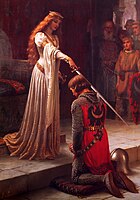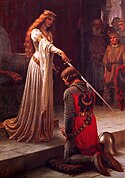Edmund Blair Leighton
| Edmund Blair Leighton | |
 Edmund Blair Leighton år 1900. | |
| Född | Edmund Blair Leighton 21 september 1852 London, England |
|---|---|
| Död | 1 september 1922 (69 år) London, England |
| Nationalitet | Brittisk |
| Yrke/uppdrag | Målare |
Edmund Blair Leighton, född 21 september 1852[1] i London, död 1 september 1922 i London, var en engelsk målare. Han tillhörde prerafaeliterna. Blair Leighton målade framförallt motiv från medeltiden samt det tidiga 1800-talet (den så kallade Regency-eran c. 1811 – 1820), ofta föreställande kvinnor och riddare.
Edmund Blair Leighton var son till konstnären Charles Blair Leighton (1823–1855), som dog innan Edmund hunnit fylla tre år, och Caroline Leighton (née Boosey).[2] Han utbildade sig vid University College School i nordvästra London därefter vid Royal Academy of Arts.
1885 gifte han sig med Katherine Nash och de fick en dotter och en son (E. J. Blair Leighton som även han tog upp målningen som yrke).
Urval av målningar
- Conquest, 1884
- Call to Arms, 1888
- Lady Godiva, 1892
- My Next-Door Neighbour, 1894
- The Charity of St. Elizabeth of Hungary, 1895
- In Time of Peril, 1897
- God Speed, 1900
- The Accolade, 1901
- Tristan and Isolde, 1902
- A Little Prince likely in Time to bless a Royal Throne (eller Vox Populi), 1904
- The Dedication, 1908
- The Shadow, c. 1909
- Stitching the Standard, 1911
- The Hostage, 1912
- My Fair Lady, 1914
Källor
Noter
Externa länkar
 Wikimedia Commons har media som rör Edmund Blair Leighton.
Wikimedia Commons har media som rör Edmund Blair Leighton.- Edmund Blair Leighton hos Europeana
|
Media som används på denna webbplats
A Little Prince likely in Time to bless a Royal Throne (or Vox Populi)
Photo of Edmund Blair Leighton in 1900, originally published in the Art Journal of the same year.
The Shadow is based upon the Greek myth of Debutades's daughter, a Corinthian girl who drew the portrait of her beloved on the wall of her bed-chamber by tracing the outline of his shadow cast by the lamp-light on the night before he departed for war. Leighton changed the setting for the drama to the battlements of a medieval castle, below which the young crusader's ships are waiting.
Two other versions of The Shadow are known; one is in the Berman Museum in Anniston, Alabama (formerly the collection of Farley and Germaine Berman, purchased in these rooms, 3 May 1972, lot 140) and the other is in Cardiff City Hall. One of the versions was exhibited at the Royal Academy in 1909.































